Abstract: Cross-silo federated learning (FL) leverages homomorphic encryption (HE) to obscure the model updates from the clients. However, HE poses the challenges of complex cryptographic computations and inflated ciphertext sizes. As cross-silo FL scales to accommodate larger models and more clients, the overheads of HE can overwhelm a CPU-centric aggregator architecture, including excessive network traffic, enormous data volume, intricate computations, and redundant data movements. Tackling these issues, we propose Flagger, an efficient and high-performance FL aggregator. Flagger meticulously integrates the data processing unit (DPU) with computational storage drives (CSD), employing these two distinct near-data processing (NDP) accelerators as a holistic architecture to collaboratively enhance FL aggregation. With the delicate delegation of complex FL aggregation tasks, we build Flagger-DPU and Flagger-CSD to exploit both in-network and in-storage HE acceleration to streamline FL aggregation. We also implement Flagger-Runtime, a dedicated software layer, to coordinate NDP accelerators and enable direct peer-to-peer data exchanges, markedly reducing data migration burdens. Our evaluation results reveal that Flagger expedites the aggregation in FL training iterations by 436% on average, compared with traditional CPU-centric aggregators.
Main figure:
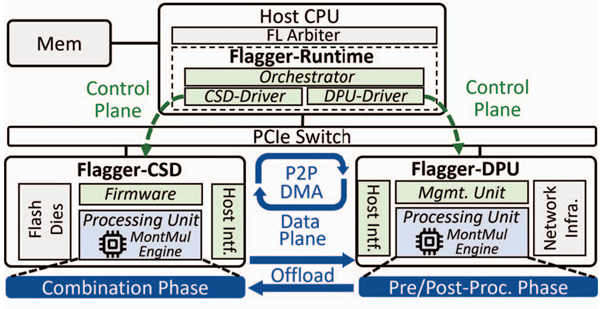
Abstract: Processing data in storage is an energy-efficient solution to examine massive datasets. However, a general incarnation of such well-known task-offloading model in a real system is unfortunately unsuccessful due to not only poor performance but also many practical challenges, such as limited processing capabilities and high vulnerabilities at the storage-level. We propose DockerSSD, a fully flexible in-storage processing (ISP) model that can run a variety of applications near flash without their source-level modification. Specifically, it enables lightweight OS-level virtualization in modern SSDs, which allows the storage intelligence to be well harmonized with existing computing environment and makes ISP even faster. Instead of developing a vendor-specific ISP to offload, DockerSSD can reuse existing Docker images, create containers as a self-governing execution object in storage, and process data directly where they are in real-time. To this end, we design a new communication method and virtual firmware that operate together to download Docker images and manage their container execution without a change of the existing storage interface and runtime. We further accelerate ISP and reduce the execution latency by automating container-related network and I/O handling data paths over hardware. Our evaluation shows that DockerSSD is 2.0 × faster than state-of-the-art ISP models for workloads with a high volume of system calls or file accesses. Moreover, it demonstrates a reduction in power and energy consumption by 1.6 × and 2.3 × respectively.
Main figure:

Abstract: Training recommendation systems (RecSys) faces several challenges as it requires the “data preprocessing” stage to preprocess an ample amount of raw data and feed them to the GPU for training in a seamless manner. To sustain high training throughput, state-of-the-art solutions reserve a large fleet of CPU servers for preprocessing which incurs substantial deployment cost and power consumption. Our characterization reveals that prior CPU-centric preprocessing is bottlenecked on feature generation and feature normalization operations as it fails to reap out the abundant inter-/intra-feature parallelism in RecSys preprocessing. PreSto is a storage-centric preprocessing system leveraging In-Storage Processing (ISP), which offloads the bottlenecked preprocessing operations to our ISP units. We show that PreSto outperforms the baseline CPU-centric system with a 9.6× speedup in end-to-end preprocessing time, 4.3× enhancement in cost-efficiency, and 11.3× improvement in energy-efficiency on average for production-scale RecSys preprocessing.
Main figure:

Abstract: With the increasing popularity of recommendation systems (RecSys), the demand for compute resources in data-centers has surged. However, the model-wise resource allocation employed in current RecSys model serving architectures falls short in effectively utilizing resources, leading to sub-optimal total cost of ownership. We propose ElasticRec, a model serving architecture for RecSys providing resource elasticity and high memory efficiency. ElasticRec is based on a microservice-based software architecture for fine-grained resource allocation, tailored to the heterogeneous resource demands of RecSys. Additionally, ElasticRec achieves high memory efficiency via our utility-based resource allocation. Overall, ElasticRec achieves an average 3.3× reduction in memory allocation size and 8.1× increase in memory utility, resulting in an average 1.6× reduction in deployment cost compared to state-of-the-art RecSys inference serving system.
Main figure:
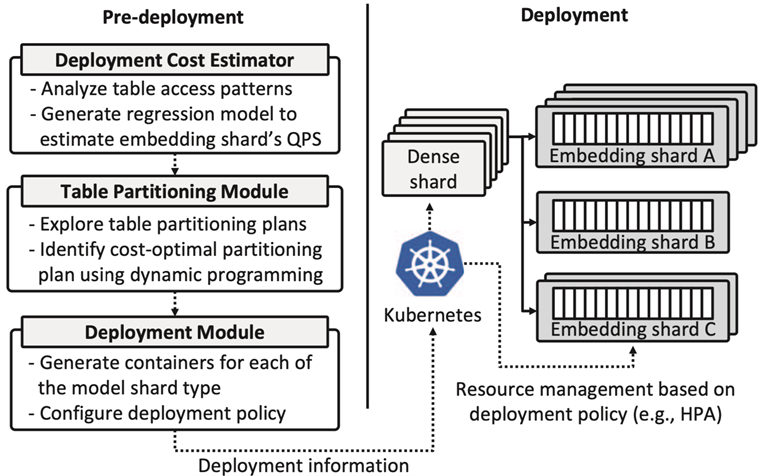
Abstract: Differential privacy (DP) is widely being employed in the industry as a practical standard for privacy protection. While private training of computer vision or natural language processing applications has been studied extensively, the computational challenges of training of recommender systems (RecSys) with DP have not been explored. In this work, we first present our detailed characterization of private RecSys training using DP-SGD, root-causing its several performance bottlenecks. Specifically, we identify DP-SGD’s noise sampling and noisy gradient update stage to suffer from a severe compute and memory bandwidth limitation, respectively, causing significant performance overhead in training private RecSys. Based on these findings, we propose LazyDP, an algorithm-software co-design that addresses the compute and memory challenges of training RecSys with DP-SGD. Compared to a state-of-the-art DP-SGD training system, we demonstrate that LazyDP provides an average 119× training throughput improvement while also ensuring mathematically equivalent, differentially private RecSys models to be trained.
Main figure:
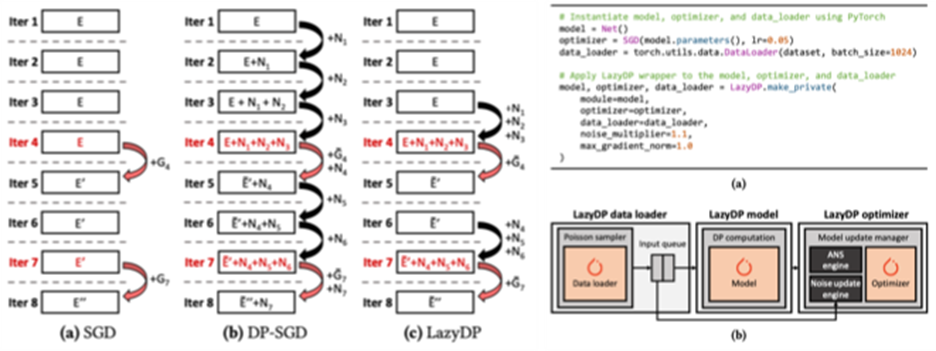
Abstract: Deep neural network (DNN)-based recommendation systems (RecSys) are one of the most successfully deployed machine learning applications in commercial services for predicting ad click-through rates or rankings. While numerous prior work explored hardware and software solutions to reduce the training time of RecSys, its end-to-end training pipeline including the data preprocessing stage has received little attention. In this work, we provide a comprehensive analysis of RecSys data preprocessing, root-causing the feature generation and normalization steps to cause a major performance bottleneck. Based on our characterization, we explore the efficacy of an FPGA-accelerated RecSys preprocessing system that achieves a significant 3.4–12.1× end-to-end speedup compared to the baseline CPU-based RecSys preprocessing system.
Main figure:
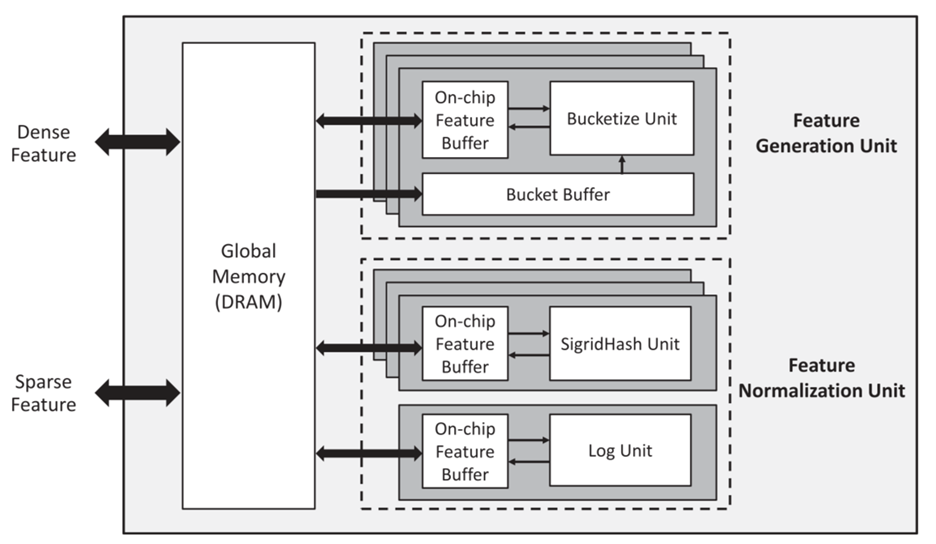
Abstract: Biased data can lead to unfair machine learning models, highlighting the importance of embedding fairness at the beginning of data analysis, particularly during dataset curation and labeling. In response, we propose Falcon, a scalable fair active learning framework. Falcon adopts a data-centric approach that improves machine learning model fairness via strategic sample selection. Given a user-specified group fairness measure, Falcon identifies samples from “target groups” (e.g., (attribute=female, label=positive)) that are the most informative for improving fairness. However, a challenge arises since these target groups are defined using ground truth labels that are not available during sample selection. To handle this, we propose a novel trial-and-error method, where we postpone using a sample if the predicted label is different from the expected one and falls outside the target group. We also observe the trade-off that selecting more informative samples results in higher likelihood of postponing due to undesired label prediction, and the optimal balance varies per dataset. We capture the trade-off between informativeness and postpone rate as policies and propose to automatically select the best policy using adversarial multi-armed bandit methods, given their computational efficiency and theoretical guarantees. Experiments show that Falcon significantly outperforms existing fair active learning approaches in terms of fairness and accuracy and is more efficient. In particular, only Falcon supports a proper trade-off between accuracy and fairness where its maximum fairness score is 1.8-4.5x higher than the second-best results.
Main Figure: 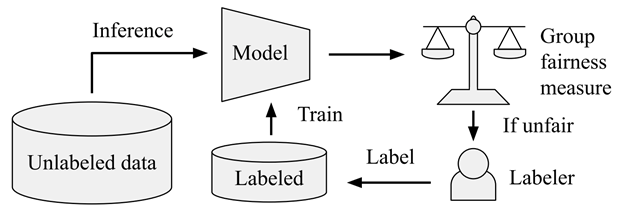
Abstract: Fine-tuning is becoming widely used for leveraging the power of pre-trained foundation models in new downstream tasks. While there are many successes of fine-tuning on various tasks, recent studies have observed challenges in the generalization of fine-tuned models to unseen distributions (i.e., out-of-distribution; OOD). To improve OOD generalization, some previous studies identify the limitations of fine-tuning data and regulate fine-tuning to preserve the general representation learned from pre-training data. However, potential limitations in the pre-training data and models are often ignored. In this paper, we contend that overly relying on the pre-trained representation may hinder fine-tuning from learning essential representations for downstream tasks and thus hurt its OOD generalization. It can be especially catastrophic when new tasks are from different (sub)domains compared to pre-training data. To address the issues in both pre-training and fine-tuning data, we propose a novel generalizable fine-tuning method LEVI (Layer-wise Ensemble of different VIews), where the pre-trained model is adaptively ensembled layer-wise with a small task-specific model, while preserving its efficiencies. By combining two complementing models, LEVI effectively suppresses problematic features in both the fine-tuning data and pre-trained model and preserves useful features for new tasks. Broad experiments with large language and vision models show that LEVI greatly improves fine-tuning generalization via emphasizing different views from fine-tuning data and pre-trained features.
Main Figure:

Abstract: We study the problem of robust data augmentation for regression tasks in the presence of noisy data. Data augmentation is essential for generalizing deep learning models, but most of the techniques like the popular Mixup are primarily designed for classification tasks on image data. Recently, there are also Mixup techniques that are specialized to regression tasks like C-Mixup. In comparison to Mixup, which takes linear interpolations of pairs of samples, C-Mixup is more selective in which samples to mix based on their label distances for better regression performance. However, C-Mixup does not distinguish noisy versus clean samples, which can be problematic when mixing and lead to suboptimal model performance. At the same time, robust training has been heavily studied where the goal is to train accurate models against noisy data through multiple rounds of model training. We thus propose our data augmentation strategy RC-Mixup, which tightly integrates C-Mixup with multi-round robust training methods for a synergistic effect. In particular, C-Mixup improves robust training in identifying clean data, while robust training provides cleaner data to C-Mixup for it to perform better. A key advantage of RC-Mixup is that it is data-centric where the robust model training algorithm itself does not need to be modified, but can simply benefit from data mixing. We show in our experiments that RC-Mixup significantly outperforms C-Mixup and robust training baselines on noisy data benchmarks and can be integrated with various robust training methods.
Main Figure:

Abstract: Large language models (LLMs) have achieved unprecedented performances in various applications, yet evaluating them is still challenging. Existing benchmarks are either manually constructed or are automatic, but lack the ability to evaluate the thought process of LLMs with arbitrary complexity. We contend that utilizing existing relational databases based on the entity-relationship (ER) model is a promising approach for constructing benchmarks as they contain structured knowledge that can be used to question LLMs. Unlike knowledge graphs, which are also used to evaluate LLMs, relational databases have integrity constraints that can be used to better construct complex in-depth questions and verify answers: (1) functional dependencies can be used to pinpoint critical keywords that an LLM must know to properly answer a given question containing certain attribute values; and (2) foreign key constraints can be used to join relations and construct multi-hop questions, which can be arbitrarily long and used to debug intermediate answers. We thus propose ERBench, which uses these integrity constraints to convert any database into an LLM benchmark. ERBench supports continuous evaluation as databases change, multimodal questions, and various prompt engineering techniques. In our experiments, we construct LLM benchmarks using databases of multiple domains and make an extensive comparison of contemporary LLMs. We show how ERBench can properly evaluate any LLM by not only checking for answer correctness, but also effectively verifying the rationales by looking for the right keywords.
Main Figure:









